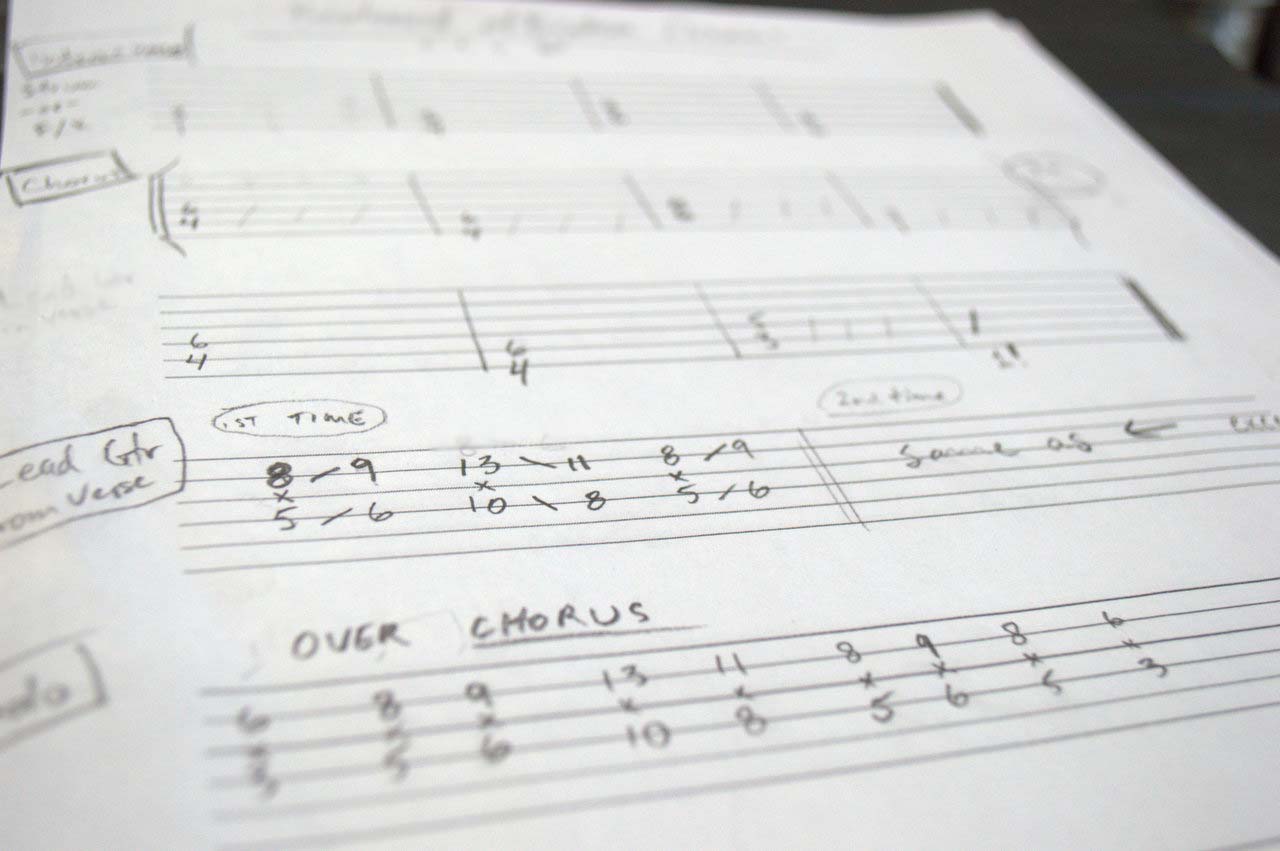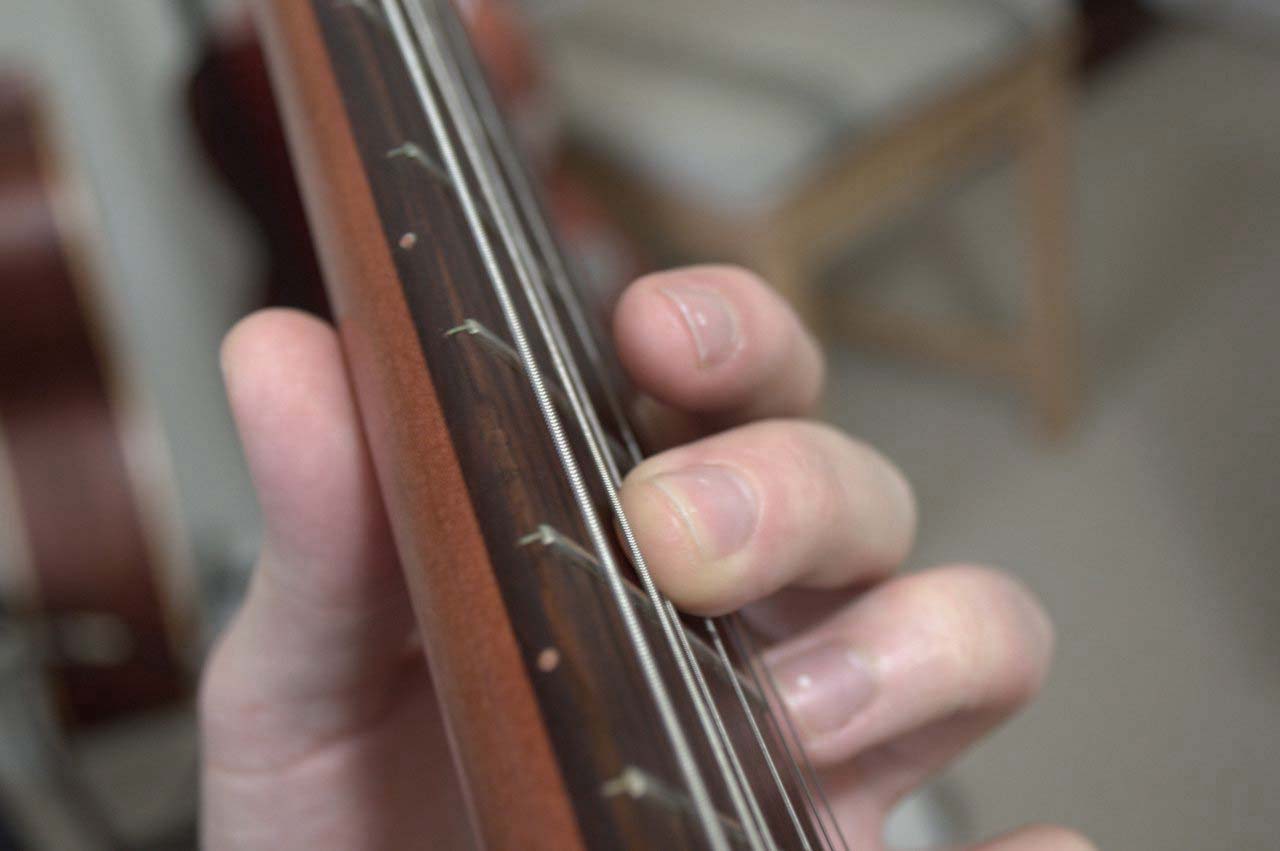Over the past few years, while building my teaching “dojo” (as one of my former teachers would call it) I’ve learned a lot of things about how students learn. I didn’t have it all figured out from the start. I learned, through experience, how to walk the fine line between the information side of things – scales, chords, theory, building an ear – and the more practical side. And as I’ve gotten to know my students better, I’ve realized that an even more important part of the learning process is to be thorough.
Even though this article goes over the specifics of learning a riff, what’s really important is the methodology. What we’re trying to promote here is being thorough. This applies not only to riffs, but to any kind of playing, whether it’s strumming along or ripping a solo. When you practice, it’s important to be thorough, going over your topic of choice from as many perspectives as possible.
As simple as that seems, this is a really common barrier for a lot of guitarists. Some people feel they can’t progress any further because they keep trying to play more notes or better notes or faster notes. There are so many other things that can make your playing musical. Victor Wooten has a really good way of saying this in his book The Music Lesson that I’ll try my best to summarize (sorry to Mr. Wooten if my interpretation isn’t what he was getting at 🙂 )
These other aspects of music – groove, dynamics, phrasing, etc. – are just as important but often go neglected. You need to be as good at those as you are at the most commonly practiced aspects of music – pitch and rhythm. The easiest gains are always to be had at the beginning, and even just a little bit of work on phrasing or dynamics would do so much more for your scales than learning yet another scale would.
So what is the goal?
Your ultimate goal is to make it sound like the recording is coming out of your guitar! You will need to pay attention to the notes, rhythm, feel, tone and every other aspect of the riff that helps make it special.
This is too easy!
Are you sure? Once you have the notes and rhythm under your fingers, how about getting the exact same guitar tone? How about trying to make every single note sound exactly like the recording – paying attention to dynamics, inflection, accents, vibrato and other musical devices? As you get better and your ear gets better, you’ll become more and more critical and precise at getting an exact sound and this is the very best way to practice that!
So what, exactly, should I do then?
Step 1 – Listen to the riff
Actively listen a few times each day for a few days
- Do NOT underestimate the importance of listening to the riff, there are many nuances that you will only hear after becoming very familiar with the riff you are learning
[fusion_builder_container hundred_percent=”yes” overflow=”visible”][fusion_builder_row][fusion_builder_column type=”1_1″ background_position=”left top” background_color=”” border_size=”” border_color=”” border_style=”solid” spacing=”yes” background_image=”” background_repeat=”no-repeat” padding=”” margin_top=”0px” margin_bottom=”0px” class=”” id=”” animation_type=”” animation_speed=”0.3″ animation_direction=”left” hide_on_mobile=”no” center_content=”no” min_height=”none”]

[fusion_separator style_type=”shadow” top_margin=”0″ bottom_margin=”20″/]
Step 2 – Memorize the notes
Practice in 15-30 minute sessions, every day until you have it memorized
- If it’s a longer riff, you must break it down into smaller bits, learn them, and then glue it all together
- Pay attention to how it is played: are there any slides? bends? hammer-ons? accents? volume-changes?
- Be sure to practice it slowly and evenly at first, and once you can play it perfectly, you are ready to speed it up
[/fusion_builder_column][fusion_builder_column type=”1_1″ background_position=”left top” background_color=”” border_size=”” border_color=”” border_style=”solid” spacing=”yes” background_image=”” background_repeat=”no-repeat” padding=”” margin_top=”0px” margin_bottom=”0px” class=”” id=”” animation_type=”” animation_speed=”0.3″ animation_direction=”left” hide_on_mobile=”no” center_content=”no” min_height=”none”]

[fusion_separator style_type=”shadow” top_margin=”0″ bottom_margin=”20″/]
Step 3 – Play it with a metronome
Practice in 15-30 minute sessions, every day until you have it memorized
- Start slow enough that you can play along, then gradually increase the tempo
- This step is good for getting you up-to-speed with the original recording
- You will hear what you sound like on your own, without a recording backing you up
[/fusion_builder_column][fusion_builder_column type=”1_1″ background_position=”left top” background_color=”” border_size=”” border_color=”” border_style=”solid” spacing=”yes” background_image=”” background_repeat=”no-repeat” padding=”” margin_top=”0px” margin_bottom=”0px” class=”” id=”” animation_type=”” animation_speed=”0.3″ animation_direction=”left” hide_on_mobile=”no” center_content=”no” min_height=”none”]

[fusion_separator style_type=”shadow” top_margin=”0″ bottom_margin=”20″/]
Step 4 – Play with the original recording
Play along with the recording a few times, throughout the day – have fun!
- make sure you can hear yourself and the recording clearly and separately
- play along many times over the course of many days/weeks to absorb the mojo directly from the recording
- YouTube has a feature that lets you play videos at different speeds – press the gear icon and select a slower playback speed if the riff is too fast to play along with
[/fusion_builder_column][fusion_builder_column type=”1_1″ background_position=”left top” background_color=”” border_size=”” border_color=”” border_style=”solid” spacing=”yes” background_image=”” background_repeat=”no-repeat” padding=”” margin_top=”0px” margin_bottom=”0px” class=”” id=”” animation_type=”” animation_speed=”0.3″ animation_direction=”left” hide_on_mobile=”no” center_content=”no” min_height=”none”]

[fusion_separator style_type=”shadow” top_margin=”0″ bottom_margin=”20″/]
Step 5 – Adjust your sound and touch
Every time you practice it, from now on
- This is the time to evaluate the way you play the riff, making sure that you are playing it with the same feel as the original recording
- Take a moment to adjust your amp and effects if you are using an electric guitar, comparing them to the sound from the original recording
[/fusion_builder_column][fusion_builder_column type=”1_1″ background_position=”left top” background_color=”” border_size=”” border_color=”” border_style=”solid” spacing=”yes” background_image=”” background_repeat=”no-repeat” padding=”” margin_top=”0px” margin_bottom=”0px” class=”” id=”” animation_type=”” animation_speed=”0.3″ animation_direction=”left” hide_on_mobile=”no” center_content=”no” min_height=”none”]

[fusion_separator style_type=”shadow” top_margin=”0″ bottom_margin=”20″/]
Give your riffs some of your time and you will be rewarded.
Incorporating the things you like to listen to into your playing doesn’t make you a copy-cat. After a while, once these things sink in, they will mix and meld with everything else you’ve learned. And if you learned these things well – squeezing every last drop of mojo from them – your playing will sound all the better for it.
See you next time!
[/fusion_builder_column][/fusion_builder_row][/fusion_builder_container]
